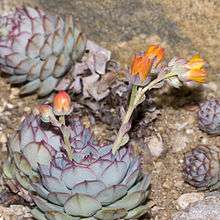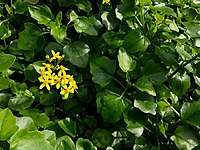Succulent plant
In botany, succulent plants, also known as succulents, are plants with parts that are thickened, fleshy, and engorged, usually to retain water in arid climates or soil conditions. The word succulent comes from the Latin word sucus, meaning 'juice', or 'sap'.[1] Succulent plants may store water in various structures, such as leaves and stems. Some definitions also include roots, thus geophytes that survive unfavorable periods by dying back to underground storage organs may be regarded as succulents. In horticultural use, the term succulent is sometimes used in a way which excludes plants that botanists would regard as succulents, such as cacti. Succulents are often grown as ornamental plants because of their striking and unusual appearance, as well as their ability to thrive with relatively minimal care.

Many plant families have multiple succulents found within them (over 25 plant families).[2] In some families, such as Aizoaceae, Cactaceae, and Crassulaceae, most species are succulents. The habitats of these water preserving plants are often in areas with high temperatures and low rainfall, such as deserts. Succulents have the ability to thrive on limited water sources, such as mist and dew, which makes them equipped to survive in an ecosystem which contains scarce water sources.
Definition
A general definition of succulents is that they are drought resistant plants in which the leaves, stem, or roots have become more than usually fleshy by the development of water-storing tissue.[3] Other sources exclude roots as in the definition "a plant with thick, fleshy and swollen stems and/or leaves, adapted to dry environments".[4] This difference affects the relationship between succulents and "geophytes" – plants that survive unfavorable seasons as a resting bud on an underground organ.[5] These underground organs, such as bulbs, corms and tubers, are often fleshy with water-storing tissues. Thus if roots are included in the definition, many geophytes would be classed as succulents. Plants adapted to living in dry environments such as succulents are termed xerophytes. However, not all xerophytes are succulents, since there are other ways of adapting to a shortage of water, e.g., by developing small leaves which may roll up or having leathery rather than succulent leaves.[6] Nor are all succulents xerophytes, since plants like Crassula helmsii are both succulent and aquatic.[7]
Those who grow succulents as a hobby use the term in a different way from botanists. In horticultural use, the term succulent regularly excludes cacti. For example, Jacobsen's three volume Handbook of Succulent Plants does not cover cacti,[8] and "cacti and succulents" is the title or part of the title of many books covering the cultivation of these plants.[9][10][11] However, in botanical terminology, cacti are succulents.[3] Horticulturists may also exclude other groups of plants, e.g., bromeliads.[12] A practical, but unscientific, horticultural definition is "a succulent plant is any desert plant that a succulent plant collector wishes to grow."[13] Such plants less often include geophytes (in which the swollen storage organ is wholly underground) but do include plants with a caudex,[14] which is a swollen above-ground organ at soil level, formed from a stem, a root or both.[5]
A further difficulty is that plants are not either succulent or non-succulent. In many genera and families there is a continuous gradation from plants with thin leaves and normal stems to those with very clearly thickened and fleshy leaves or stems, so that deciding what is a succulent is often arbitrary. Different sources may classify the same species differently.[15]
Appearance
The storage of water often gives succulent plants a more swollen or fleshy appearance than other plants, a characteristic known as succulence. In addition to succulence, succulent plants variously have other water-saving features. These may include:
- Crassulacean acid metabolism (CAM) to minimize water loss
- absent, reduced, or cylindrical-to-spherical leaves
- reduction in the number of stomata
- stems as the main site of photosynthesis, rather than leaves
- compact, reduced, cushion-like, columnar, or spherical growth form
- ribs enabling rapid increases in plant volume and decreasing surface area exposed to the sun
- waxy, hairy, or spiny outer surface to create a humid micro-habitat around the plant, which reduces air movement near the surface of the plant, and thereby reduces water loss and creates shade
- roots very near the surface of the soil, so they are able to take up moisture from very small showers or even from heavy dew
- ability to remain plump and full of water even with high internal temperatures (e.g., 52 °C or 126 °F)[16]
- very impervious outer cuticle (skin)[16]
- mucilaginous substances, which retain water abundantly[16]
Habitat
Other than Antarctica, succulents can be found within each continent. While it is often thought that most succulents come from dry areas such as steppes, semi-desert, and desert, the world's driest areas do not make for proper succulent habitats. Australia, the world's driest continent, hosts very few native succulents due to the frequent and prolonged droughts. Even Africa, the continent with the most native succulents, does not host many of the plants in its most dry regions.[17] However, while succulents are unable to grow in these harshest of conditions, they are able to grow in conditions that are uninhabitable by other plants. In fact, many succulents are able to thrive in dry conditions, and some are able to last up to two years without water depending on their surroundings and adaptations.[18] Succulents may also occasionally occur as epiphytes, growing on other plants with limited or no contact with the ground, and are dependent on their ability to store water and gain nutrients by other means; this niche is seen in Tillandsia. Succulents also occur as inhabitants of sea coasts and dry lakes, which are exposed to high levels of dissolved minerals that are deadly to many other plant species. Potted succulents are able to grow in most indoor environments with minimal care.[19]
Families and genera

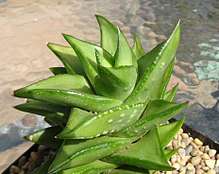


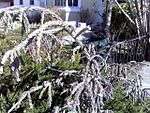

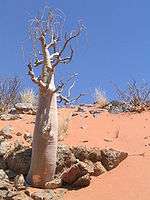

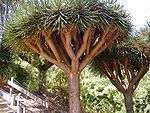
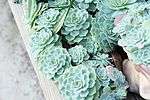
There are approximately sixty different plant families that contain succulents.[20] Plant orders, families, and genera in which succulent species occur are listed below.
Order Alismatales
Order Apiales
Order Asparagales
- Amaryllidaceae (geophytes): Amaryllis, Boophane, Clivia, Crinum, Cryptostephanus, Cyrtanthus, Haemanthus, Rauhia, Scadoxus, Stenomesson
- Asparagaceae
- Agavoideae: Agave, Beschorneria, Dracaena, Furcraea, Hesperaloe, Hesperoyucca, Manfreda, Polianthes, Yucca
- Lomandroideae: Cordyline
- Nolinoideae: Beaucarnea, Calibanus, Dasylirion, Nolina, Sansevieria
- Scilloideae (Hyacinthaceae): Albuca, Bowiea, Daubenya, Drimia, Eucomis, Lachenalia, Ledebouria, Massonia, Ornithogalum, Scilla, Urginea, Veltheimia
- Doryanthaceae: Doryanthes
- Orchidaceae: Acampe, Aerangis, Ansellia, Bolusiella, Bulbophyllum, Cirrhopetalum, Calanthe, Cyrtorchis, Eulophia, Liparis, Oberonia, Oeceoclades, Polystachya, Tridactyle, Vanilla
- Asphodelaceae
- subfamily Asphodeloideae: Aloe (succulents and succulent geophytes), Astroloba, Tulista, × Astrolista, Bulbine (succulent geophytes, succulents, and geophytes), Bulbinella (geophyte), Chortolirion (succulent geophytes), Gasteria, Haworthia, Trachyandra (succulent geophytes and succulents),
- subfamily Xanothorrhoeoidae: Xanthorrhoea
Order Asterales
- Asteraceae: Arctotheca, Baeriopsis, Chrysanthemoides, Coulterella, Crassocephalum, Didelta, Emilia, Eremothamnus, Gymnodiscus, Gynura, Hillardiella (geophyte), Lopholaena, Monoculus, Nidorella, Osteospermum, Othonna (succulents and succulent geophytes), Phaneroglossa, Poecilolepis, Polyachyrus, Pteronia, Senecio, Solanecio,Tripteris
- Campanulaceae: Brighamia
Order Brassicales
- Brassicaceae: Heliophila, Lepidium
- Capparidaceae: Maerua
- Caricaceae: Carica, Jacarathia
- Moringaceae: Moringa
Order Caryophyllales
- Aizoaceae: Corbichonia, Gisekia, Herreanthus, Limeum, Ophthalmophyllum, Saphesia
- subfamily Aizooideae: Acrosanthes, Aizoanthemum, Aizoon, Galenia, Gunniopsis, Plinthus, Tetragonia
- subfamily Mesembryanthemoideae (syn. Mesembryanthemaceae[22]): Aptenia, Aridaria, Aspazoma, Brownanthus, Calamophyllum, Caulipsilon, Conophytum, Dactylopsis, Erepsia, Hameria, Hartmanthus, Hymenogyne, Marlothistela, Mesembryanthemum, Phiambolia, Phyllobolus, Prenia, Psilocaulon, Ruschiella, Sarozona, Sceletium, Synaptophyllum
- subfamily Ruschioideae:
- tribe Apatesieae: Apatesia, Carpanthea, Caryotophora, Conicosia, Hymenogyne, Saphesia, Skiatophytum
- tribe Dorotheantheae: Aethephyllum Cleretum Dorotheanthus
- tribe Ruschiae: Acrodon, Aloinopsis, Amphibolia, Antegibbaeum, Antimima, Arenifera, Argyroderma, Astridia, Bergeranthus, Bijlia, Braunsia, Brianhuntleya, Carpobrotus, Carruanthus, Cephalophyllum, Cerochlamys, Chasmatophyllum, Cheiridopsis, Circandra, Conophytum, Corpuscularia, Cylindrophyllum, Delosperma, Dicrocaulon, Didymaotus, Dinteranthus, Diplosoma, Disphyma, Dracophilus, Drosanthemum, Eberlanzia, Ebracteola, Enarganthe, Erepsia, Esterhuysenia, Faucaria, Fenestraria, Frithia, Gibbaeum, Glottiphyllum, Hallianthus, Hereroa, Ihlenfeldtia, Imitaria, Jacobsenia, Jensenobotrya, Jordaaniella, Juttadinteria, Khadia, Lampranthus, Lapidaria (plant), Leipoldtia, Lithops, Machairophyllum, Malephora, Mestoklema, Meyerophytum, Mitrophyllum, Monilaria, Mossia, Muiria, Namaquanthus, Namibia, Nananthus, Nelia, Neohenricia, Octopoma, Odontophorus, Oophytum, Ophthalmophyllum, Orthopterum, Oscularia, Ottosonderia, Pleiospilos, Polymita, Psammophora, Rabiea, Rhinephyllum, Rhombophyllum, Ruschia, Ruschianthemum, Ruschianthus, Schlechteranthus, Schwantesia, Scopelogena, Smicrostigma, Stayneria, Stoeberia, Stomatium Tanquana Titanopsis, Trichodiadema, Vanheerdea, Vanzijlia, Vlokia, Wooleya, Zeuktophyllum
- subfamily Sesuvioideae: Cypselea, Sesuvium, Trianthema, Tribulocarpus, Zaleya
- Amaranthaceae:
- subfamily Amaranthoideae: Arthraerva
- subfamily Chenopodioideae (family Chenopodiaceae):[23]) Atriplex, Chenopodium, Dissocarpus, Einadia, Enchylaena, Eremophea, Halopeplis, Maireana, Malacocera, Neobassia, Osteocarpum, Rhagodia, Roycea, Halosarcia, Salicornia, Salsola, Sarcocornia, Sclerochlamys, Sclerolaena, Suaeda, Tecticornia, Threlkeldia
- Basellaceae: Anredera, Basella
- Cactaceae: Acanthocalycium, Acanthocereus, Ariocarpus, Armatocereus, Arrojadoa, Arthrocereus, Astrophytum, Austrocactus, Aztekium, Bergerocactus, Blossfeldia, Brachycereus, Browningia, Brasilicereus, Calymmanthium, Carnegiea, Cephalocereus, Cephalocleistocactus, Cereus, Cintia, Cipocereus, Cleistocactus, Coleocephalocereus, Copiapoa, Corryocactus, Coryphantha, Dendrocereus, Denmoza, Discocactus, Disocactus, Echinocactus, Echinocereus, Echinopsis, Epiphyllum, Epithelantha, Eriosyce, Escobaria, Escontria, Espostoa, Espostoopsis, Eulychnia, Facheiroa, Ferocactus, Frailea, Geohintonia, Gymnocalycium, Haageocereus, Harrisia, Hatiora, Hylocereus, Jasminocereus, Lasiocereus, Leocereus, Lepismium, Leptocereus, Leuchtenbergia, Lophophora, Maihuenia, Malacocarpus, Mammillaria, Mammilloydia, Matucana, Melocactus, Micranthocereus, Mila, Monvillea, Myrtillocactus, Neobuxbaumia, Neolloydia, Neoraimondia, Neowerdermannia, Obregonia, Opuntia, Oreocereus, Oroya, Ortegocactus, Pachycereus, Parodia, Pediocactus, Pelecyphora, Peniocereus, Pereskia, Pereskiopsis, Pilosocereus, Polaskia, Praecereus, Pseudoacanthocereus, Pseudorhipsalis, Pterocactus, Pygmaeocereus, Quiabentia, Rauhocereus, Rebutia, Rhipsalis, Samaipaticereus, Schlumbergera, Sclerocactus, Selenicereus, Stenocactus, Stenocereus, Stephanocereus, Stetsonia, Strombocactus, Tacinga, Thelocactus,Trichocereus Turbinicarpus, Uebelmannia, Weberbauerocereus, Weberocereus, Yungasocereus
- Didiereaceae: Alluaudia, Alluaudiopsis, Decaria, Didierea
- Molluginaceae: Hypertelis
- Phytolaccaceae: Phytolacca
- Portulacaceae: Amphipetalum, Anacampseros, Avonia, Calyptrotheca, Ceraria, Cistanthe, Calandrinia, Dendroportulaca, Grahamia, Lewisia, Parakeelya,[24] Portulaca, Portulacaria, Schreiteria, Talinella, Talinum
Order Commelinales
Order Cornales
- Loasaceae: Schismocarpus
Order Cucurbitales
- Begoniaceae: Begonia
- Cucurbitaceae: Acanthosicyos, Apodanthera, Brandegea, Cephalopentandra, Ceratosanthes, Citrullus, Coccinia, Corallocarpus, Cucumella, Cucumis, Cucurbita, Cyclantheropsis, Dactyliandra, Dendrosicyos, Doyera, Eureindra, Fevillea, Gerrandanthus, Gynostemma, Halosicyos, Ibervilla, Kedostris, Lagenaria, Marah, Momordica, Neoalsomitra, Odosicyos, Parasicyos, Syrigia, Telfairia, Trochomeria, Trochomeriopsis, Tumamoca, Xerosicyos, Zehneria, Zygosicyos
Order Dioscoreales
Order Ericales
- Balsaminaceae: Impatiens
- Ericaceae: Sphyrospermum
- Fouquieriaceae: Fouquieria
Order Fabales
Order Gentianales
- Apocynaceae: Adenium, Mandevilla, Pachypodium, Plumeria
- subfamily Asclepiadoideae (syn. Asclepiadaceae): Absolmsia, Australluma, Aspidoglossum, Aspidonepsis, Baynesia, Brachystelma, Ceropegia, Chlorocyathus, Cibirhiza, Cordylogyne, Cynanchum, Dischidia, Dischidiopsis, Duvaliandra, Eustegia, Fanninia, Fockea, Glossostelma, Hoya, Ischnolepis, Lavrania, Marsdenia, Miraglossum, Odontostelma, Ophionella, Orbeanthus, Pachycarpus, Parapodium, Periglossum, Petopentia, Raphionacme, Riocreuxia, Sarcorrhiza, Schizoglossum, Schlechterella, Stathmostelma, Stenostelma, Stomatostemma, Trachycalymma, Trichocaulon, Tylophora, Woodia, Xysmalobium
- tribe Asclepiadeae:
- subtribe Asclepiadne: Asclepias,
- subtribe Cynanchinae: Sarcostemma,
- subtribe Gonolobinae: Matelea,
- tribe Maxillarieae:
- subtribe Lycastinae: Rudolfiella
- tribe Stapelieae: Angolluma, Caralluma, Desmidorchis, Duvalia, Echidnopsis, Edithcolea, Frerea, Hoodia, Huernia, Huerniopsis, Larryleachia, Notechidnopsis, Orbea (plant), Orbeopsis, Piaranthus, Pachycymbium, Pectinaria, Pseudolithos, Pseudopectinaria, Quaqua, Rhytidocaulon, Stapelia, Stapelianthus, Stapeliopsis, Tavaresia, Tridentea, Tromotriche, Whitesloanea
- tribe Asclepiadeae:
- subfamily Periplocoideae:
- tribe Cryptolepideae: Cryptolepis
- subfamily Asclepiadoideae (syn. Asclepiadaceae): Absolmsia, Australluma, Aspidoglossum, Aspidonepsis, Baynesia, Brachystelma, Ceropegia, Chlorocyathus, Cibirhiza, Cordylogyne, Cynanchum, Dischidia, Dischidiopsis, Duvaliandra, Eustegia, Fanninia, Fockea, Glossostelma, Hoya, Ischnolepis, Lavrania, Marsdenia, Miraglossum, Odontostelma, Ophionella, Orbeanthus, Pachycarpus, Parapodium, Periglossum, Petopentia, Raphionacme, Riocreuxia, Sarcorrhiza, Schizoglossum, Schlechterella, Stathmostelma, Stenostelma, Stomatostemma, Trachycalymma, Trichocaulon, Tylophora, Woodia, Xysmalobium
- Rubiaceae: Anthorrhiza, Anthospermum, Hydnophytum, Hydrophylax, Myrmecodia, Myrmephytum, Phylohydrax, Squamellaria
Order Geraniales
- Geraniaceae: Monsonia, Pelargonium (succulents and geophytes), Sarcocaulon
Order Lamiales
- Gesneriaceae: Aeschynanthus, Alsobia, Chirita, Codonanthe, Columnea, Nematanthus, Sinningia, Streptocarpus
- Lamiaceae: Aeollanthus, Dauphinea, Perrierastrum, Plectranthus, Rotheca, Solenostemon, Tetradenia, Thorncroftia
- Lentibulariaceae
- Pedaliaceae: Holubia, Pterodiscus, Sesamothamnus, Uncarina
Order Malpighiales
- Euphorbiaceae: Cnidoscolus, Euphorbia, Jatropha, Monadenium, Pedilanthus, Phyllanthus, Synadenium
- Passifloraceae: Adenia
- Phyllanthaceae: Phyllanthus
Order Malvales
- Cochlospermaceae
- Malvaceae: Adansonia, Cavanillesia, Ceiba, Pseudobombax
- subgroup Sterculiaceae: Brachychiton, Sterculia
Order Myrtales
Order Oxalidales
- Oxalidaceae (geophytes): Oxalis
Order Piperales
Order Poales
- Bromeliaceae: Abromeitiella, Aechmea, Ananas, Catopsis, Connellia, Dyckia, Hechtia, Neoregelia, Puya, Tillandsia, Vriesea
- Poaceae: Dregeochloa[25]
Order Ranunculales
- Menispermaceae: Chasmanthera, Stephania, Tinospora
Order Rosales
Order Santalales
- Loranthaceae: Actinanthella, Agelanthus, Erianthemum, Helixanthera, Moquiniella, Oncocalyx, Pedistylis, Plicosepalus, Septulina, Tapinanthus, Vanwykia
- Viscaceae(syn. Santalaceae): Viscum
Order Sapindales
- Anacardiaceae: Operculicaria, Pachycormus
- Burseraceae: Boswellia, Bursera, Commiphora
- Meliaceae: Entandrophragma
- Sapindaceae: Erythrophysa
Order Saxifragales
- Crassulaceae: Adromischus, Aeonium, Aichryson, Cotyledon, Crassula, Cremnophila, Dudleya, Echeveria, Graptopetalum, Greenovia, Hylotelephium, Kalanchoe, Kungia, Lenophyllum, Meterostachys, Monanthes, Mucizonia, Orostachys, Pachyphytum, Perrierosedum, Petrosedum, Phedimus, Pistorinia, Prometheum, Pseudosedum, Rhodiola, Rosularia, Sedella, Sedum, Sempervivum, Sinocrassula, Thompsonella, Tylecodon, Umbilicus, Villadia[26]
- Saxifragaceae
Order Solanales
- Convolvulaceae: Ipomoea, Merremia, Stictocardia, Turbina (plant)
- Solanaceae: Nolana
Order Vitales
Order Zygophyllales
- Zygophyllaceae: Augea, Seetzenia, Zygophyllum
(unplaced order)* Boraginaceae: Heliotropium (unplaced order)* Icacinaceae: Pyrenacantha (geophyte)
There is also some Gymnosperms :
Order Pinales
Frenelopsis, Pseudofrenelopsis, Suturovagina, Glenrosa
For some families and subfamilies, most members are succulent; for example the Cactaceae, Agavoideae, Aizoaceae, and Crassulaceae.
The table below shows the number of succulent species found in some families:
| Family or subfamily | Succulent # | Modified parts | Distribution |
|---|---|---|---|
| Agavoideae | 300 | Leaf | North and Central America |
| Cactaceae | 1600 | Stem (root, leaf) | The Americas |
| Crassulaceae | 1300 | Leaf (root) | Worldwide |
| Aizoaceae | 2000 | Leaf | Southern Africa, Australia |
| Apocynaceae | 500 | Stem | Africa, Arabia, India, Australia |
| Asphodelaceae | 500+ | Leaf | Africa, Madagascar, Australia |
| Didiereaceae | 11 | Stem | Madagascar (endemic) |
| Euphorbiaceae | > 1000 | Stem or leaf or root | Australia, Africa, Madagascar, Asia, the Americas, Europe |
| Portulacaceae | ~500 | Leaf and stem | The Americas, Australia, Africa |
| Cheirolepidiaceae | 4, maybe more | Leaf | Worldwide, excepted Antarctica |
Cultivation

Succulents are favored as houseplants for their attractiveness and ease of care. If properly potted, succulents require little maintenance to survive indoors.[27] Succulents are very adaptable houseplants and will thrive in a range of indoor conditions.[28] For most plant owners, over-watering and associated infections are the main cause of death in succulents[29].
Succulents can be propagated by different means. The most common is vegetative propagation; this includes cuttings where several inches of stem with leaves are cut and after healing produce a callus. After a week or so, roots may grow. A second method is division consisting of uprooting an overgrown clump and pulling the stems and roots apart. A third method is propagation by leaf by allowing the formation of a callus. During this method, a bottom leaf is fully removed from the plant often by twisting or cutting. The leaf then dries out and a callus forms preventing the leaf from absorbing too much moisture and thus rotting. This method typically takes up to a few weeks to produce healthy roots that will eventually create new plants.[30] The vegetative propagation can be different according to the species.[31]
References
- Merriam-Webster: succulent, retrieved 2015-04-13
- Dimmitt, Mark. "The Tucson Cactus and Succulent Society". www.tucsoncactus.org. Retrieved 5 February 2017.
- Rowley 1980, p. 1
- Beentje 2010, p. 116
- Beentje 2010, p. 32
- "xerophyte", Dictionary of Botany, 2001, retrieved 2012-09-23
- "Crassula helmsii (aquatic plant, succulent)", Global Invasive Species Database, ISSG, April 15, 2010, retrieved 2012-09-23
- Jacobsen 1960
- Anderson 1999
- Hecht 1994
- Hewitt 1993
- Innes & Wall 1995
- Martin & Chapman 1977
- Martin & Chapman 1977, pp. 19-20
- Rowley 1980, p. 2
- Compton n.d.
- "Succulents in their natural environment".
- "Cactuses and Succulents".
- "Succulent Care Tips".
- "10 Things You Never Knew About Succulents".
- "Apiaceae". succulent-plant.com. Retrieved 2018-02-07.
- Plants of Southern Africa Retrieved on 2010-1-1
- FloraBase - The Western Australian Flora Retrieved on 2010-1-1
- Parakeelya. The Plant List.
- Dregeochloa pumila. South African National Biodiversity Institute.
- "Crassulaceae Genera". Missouri Botanical Garden. Retrieved 2017-10-26.
- Kramer, Jack (1977). Cacti and Other Succulents. New York: Abrams. p. 9.
- Kramer, Jack (1977). Cacti and Other Succulents. New York: Abrams. p. 49.
- SproutingIndoors (2020-06-13). "Succulent Root Rot: What it is and How to Treat it". Sprouting Indoors. Retrieved 2020-06-15.
- "Propagating Succulents".
- Lee, Debra (2007). Designing with Succulents. Portland, Obregon: Timber Press. p. 133.
Bibliography
- Anderson, Miles (1999), Cacti and Succulents : Illustrated Encyclopedia, Oxford: Sebastian Kelly, ISBN 978-1-84081-253-4
- Beentje, Henk (2010), The Kew Plant Glossary, Richmond, Surrey: Royal Botanic Gardens, Kew, ISBN 978-1-84246-422-9
- Compton, R.H., ed. (n.d.), Our South African Flora, Cape Times Ltd, OCLC 222867742 (publication date also given as 1930s or 1940s)
- Hecht, Hans (1994), Cacti & Succulents (p/b ed.), New York: Sterling, ISBN 978-0-8069-0549-5
- Hewitt, Terry (1993), The Complete Book of Cacti & Succulents, London: Covent Garden Books, ISBN 978-1-85605-402-7
- Innes, Clive & Wall, Bill (1995), Cacti, Succulents and Bromeliads, London: Cassell for the Royal Horticultural Society, ISBN 978-0-304-32076-9
- Jacobsen, Hermann (1960), A Handbook of Succulent Plants (Vols 1–3), Poole, Dorset: Blandford Press, ISBN 978-0-7137-0140-1
- Martin, Margaret J. & Chapman, Peter R. (1977), Succulents and their cultivation, London: Faber & Faber, ISBN 978-0-571-10221-1
- Rowley, Gordon D. (1980), Name that Succulent, Cheltenham, Glos.: Stanley Thornes, ISBN 978-0-85950-447-8
External links
| Look up succulent in Wiktionary, the free dictionary. |
| Wikimedia Commons has media related to Succulents. |

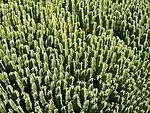
.jpg)
